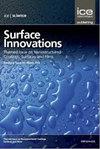Preparation and corrosion resistance of KTNT-waterborne polyurethane coatings
IF 3.5
4区 材料科学
Q3 CHEMISTRY, PHYSICAL
引用次数: 0
Abstract
In this study, titanate nanotubes (TNTs) were prepared via the hydrothermal method and then modified with γ-aminopropyltriethoxysilane (KH550) to obtain KTNTs with good dispersion properties. A KTNT-WPU composite coating was prepared by blending KTNTs with waterborne polyurethane (WPU). Fourier transform infrared spectroscopy (FT-IR) was used to characterize TNT compositions before and after modification. Thermogravimetric analysis (TGA) and electrochemical impedance spectroscopy (EIS) were used to test the thermal stability and corrosion resistance of the composite coating. The results showed that KH550 was successfully connected to the TNT surface. This improved thermal stabilities and corrosion resistances of the KTNT-WPU coatings. The fastest thermal decomposition rate for the 0.5% KTNT composite coating was 2%/min lower than that of the pure WPU coating. At the same time, the impedance of the composite coating could reach 7.58×107 Ω·cm2, the corrosion current density was 3.20×10−9 A·cm-2, and the corrosion inhibition rate reached 99.87%. The composite coating had an effective corrosion protection time of 120 h and the protective effect of the coating weakened when the immersion time exceeded 360 h.ktnt水性聚氨酯涂料的制备及其耐腐蚀性能
本研究采用水热法制备了钛酸纳米管(TNTs),然后用γ-氨基丙基三乙氧基硅烷(KH550)对其进行改性,得到了具有良好分散性能的KTNTs。将KTNTs与水性聚氨酯(WPU)共混,制备了KTNT-WPU复合涂料。利用傅立叶变换红外光谱(FT-IR)对改性前后TNT的组成进行了表征。采用热重分析(TGA)和电化学阻抗谱(EIS)测试了复合涂层的热稳定性和耐腐蚀性。结果表明,KH550成功地与TNT表面连接。这提高了KTNT-WPU涂层的热稳定性和耐腐蚀性。0.5%KTNT复合涂层的最快热分解速率比纯WPU涂层低2%/min。同时,复合涂层的阻抗可达7.58×107 Ω·cm2,腐蚀电流密度为3.20×10−9 A·cm-2,缓蚀率达到99.87%。复合涂层的有效防腐时间为120 h,并且当浸渍时间超过360时,涂层的保护作用减弱 h。
本文章由计算机程序翻译,如有差异,请以英文原文为准。
求助全文
约1分钟内获得全文
求助全文
来源期刊

Surface Innovations
CHEMISTRY, PHYSICALMATERIALS SCIENCE, COAT-MATERIALS SCIENCE, COATINGS & FILMS
CiteScore
5.80
自引率
22.90%
发文量
66
期刊介绍:
The material innovations on surfaces, combined with understanding and manipulation of physics and chemistry of functional surfaces and coatings, have exploded in the past decade at an incredibly rapid pace.
Superhydrophobicity, superhydrophlicity, self-cleaning, self-healing, anti-fouling, anti-bacterial, etc., have become important fundamental topics of surface science research community driven by curiosity of physics, chemistry, and biology of interaction phenomenon at surfaces and their enormous potential in practical applications. Materials having controlled-functionality surfaces and coatings are important to the manufacturing of new products for environmental control, liquid manipulation, nanotechnological advances, biomedical engineering, pharmacy, biotechnology, and many others, and are part of the most promising technological innovations of the twenty-first century.
 求助内容:
求助内容: 应助结果提醒方式:
应助结果提醒方式:


